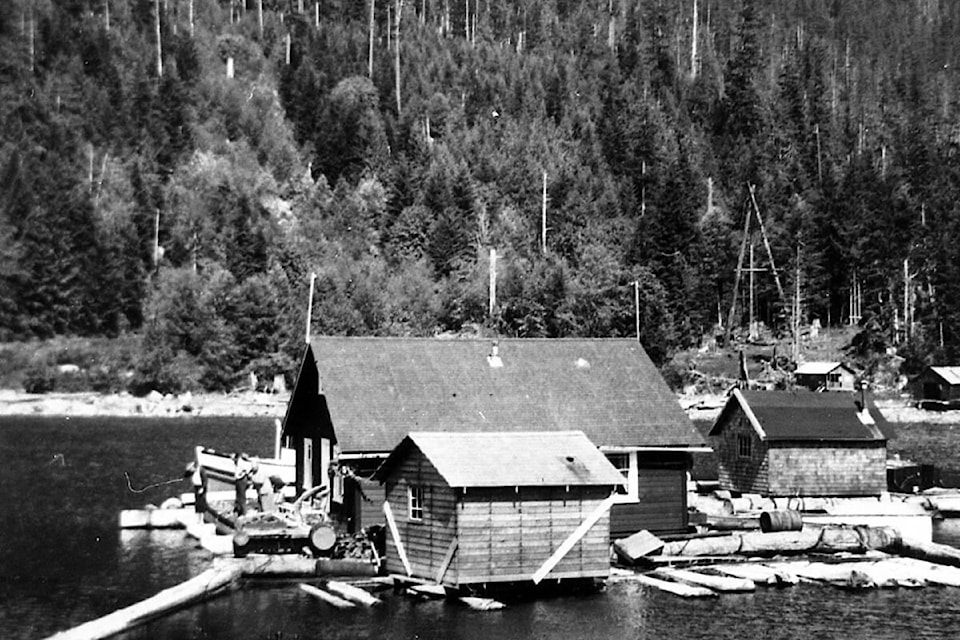When visitors to the Museum step onto the float of the floathouse exhibit and peer into the windows, they are transported back in time to a period when this unique style of housing was common along our coast.
Floating dwellings were a coastal housing adaption based on environment and circumstance. In the early 1900’s when handloggers and “gypo” operators, a term used for a small logging outfit working on a tight budget, tackled the rocky, often vertical coastal terrain, a floating camp was the perfect housing solution for keeping the crew close to the worksite. These camps consisted of either a one-family unit or an entire floating village which could be towed from place to place.
Local author Francis Dickie, who lived in the area in the late 1900’s paints a vivid picture of these floating camps:
“Upon a gathering of enormous rafts of cedar logs a cluster of houses lay. Though made up of sections, the whole was held together by boom chains and cable, presenting to the viewer an air of compactness, a community stability, that certain something one senses only in established places. Ridiculous as this impression seemed regarding a so obviously transient arrangement, the feeling grew stronger upon me as I stepped upon the planking of the city.
“I started along the main street of this astonishing floating aggregation of one-storey buildings. All were of frame, from one to five rooms in size. Several were of tar-paper covering, others of cedar shake, others of neat boards. In little yards at the front and back of these, flowers and vegetables flourished in earth held in old dug-out canoes, long boxes, barrels and tins. From the nearby shore, pipelines, tapping mountain springs, had been carried to supply the householders with running water.”
The floathouse replica in the Museum is a simple one room structure, c. 1920’s and is based on several interviews with individuals having lived experiences, most of whom were women.
Interviewee Lillian Carroll described her home in detail. Their home was a three-room shack, two small bedrooms and a main kitchen/living area with a pantry which, compared with many others, was a real luxury. The exterior walls were shingles and inside paper pasted around the wall studs provided insulation. A wood floor was kept clean with routine scrubbing with lye. The family boasted a few pieces of fine furniture – a round oak table and turned chairs, a Singer sewing machine, a couch/daybed and a nickel-plated wood cook stove.
Living on the water was not without its risk. Aside from the constant concern of children falling overboard, moving from one location to another was a risky endeavour. Mrs. Emma Carmichael shared her harrowing experience when their float house was being towed, “The fellow that was moving it around for us got into a tide rip and we nearly lost everything.” Mrs. Carmichael, who was in the float house while it was being towed, could see the situation was very dangerous. She was on her way out with a comforter that she had grabbed when she met her husband who told her “You better just take your purse, I think we are going to lose everything.” Once safely off the float, Mr. Carmichael directed the towboat operator to cut the float house loose. The Carmichaels were lucky and, eventually, the floathouse drifted to the beach and they were able to retrieve it.
August Schnarr wasn’t quite so lucky, according to his daughter Pansy Eddington, “In 1932, he brought his house down from up Bute, towing it with the little old Easthope that he had, and coming down about Stuart Island, a wind came up, he couldn’t do anything about it, it just broke the float up and the house went down to the bottom.” The home and all their belongings were lost.
Aside from moving to where the work was, another advantage of a floating home was flexibility when the children became school-age. Often the women would find a small community in the area to settle into for the winter. Mrs. Carroll noted that Greis Creek became a floathouse school community. Several floating houses “Congregated for the winter months. Everyone pulled up on shore there so the kids could go to school for the winter.” Larger floating camps often included schools for the children of the married crew members.
The prevailing attitude about living in these conditions, recalls Mrs. Carmichael was “Oh, well, we’re not staying long.” This was not to be the case for many. Over time, the same structure was upgraded and expanded and many ended up living in the same house for the remainder of their lives. Eventually, though, as this lifestyle changed, many floathouses were moved permanently onto the shore. Several of these can be seen if you have an opportunity to take one of our historic boat tours this summer.
